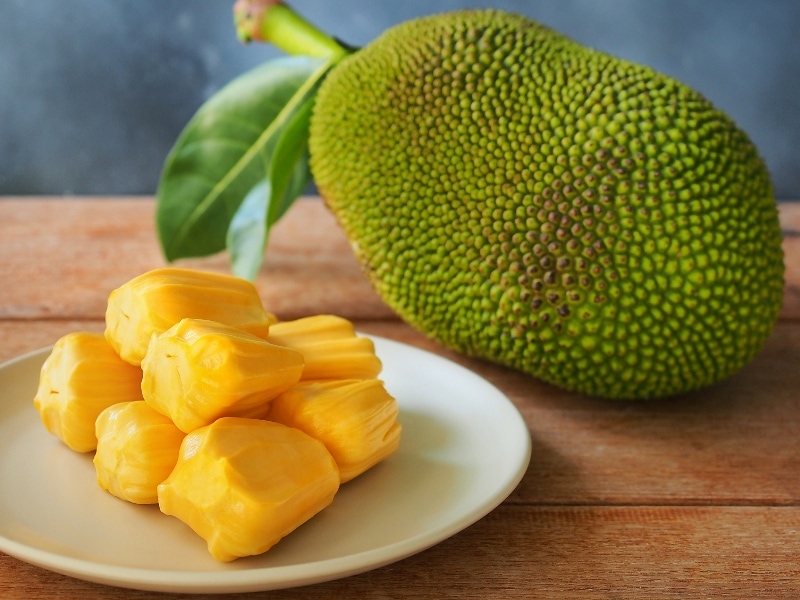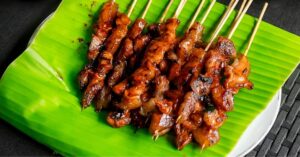These Filipino fruits are delicious, interesting, and fun!
Planet Earth is home to some unique tropical fruits, many of which live in the Philippines.
Luckily, many of these fruits are imported outside the Philippines because they are so delicious.
Some you know, and some might be unfamiliar.

Diversify your tropical fruit game outside pineapples and mangoes.
There are classics like jackfruit to coconuts to more mysterious additions like durian, cotton fruit, marang, and longan.
These Filipino fruits are sure to make your tastebuds dance!
Filipino Fruits
1. Philippine Mangoes (Mangga)

Who doesn’t love biting into a ripe, juicy mango?
Of all of the fruits from the Philippines, the Philippine mango is one of their sweetest exports.
With 14 different types of mangoes hailing from the Philippines, it’s one of their most prized fruits.
They’re sweet, juicy, and a great treat for breakfast, lunch, and dinner.
The people of the Philippines hold their mangoes in such high regard that there’s a yearly mango festival honoring this deliciously sweet fruit!
2. Custard Apple (Atis)

The custard apple, or sugar apple, is known as atis.
It doesn’t look like your typical apple and looks like a fruit growing on a different planet.
However, with one bite, you’ll recognize the flavor!
The flavors of the custard apple are exactly what you’d expect. It tastes like a custard apple.
It hosts a subtly sweet apple flavor with a creamy, custard-like finish.
Sure, it looks like a brain on the outside but tastes like a whole custard apple dessert on the inside.
3. Soursop (Guyabano)

Soursop is another one of those fruits whose looks are deceiving.
The outside is rough and prickly, but the insides are nice and creamy.
When ripe, the soursop fruit is a fusion between a bright, citrus fruit with a creamy texture similar to a banana.
And the uses for soursop are virtually endless.
You can eat it raw, top it on your morning cereal or oatmeal, or blend it in a smoothie for a sweet, citrus, and creamy finish.
4. Cotton Fruit (Santol)

While the outside of the cotton fruit looks like a small coconut, the insides resemble orange and white cotton candy.
And that’s precisely where it gets its name.
Cotton fruit has cotton-like insides that are so delicate and airy. It has a flavor that shifts as it ripens.
When immature, it’s more sour than sweet, with gentle floral notes.
As it ripens, the flavors are much sweeter and less acidic.
5. Sapodilla (Chico)

The sapodilla looks like a potato. The outsides don’t scream deliciously sweet and indulgent, but those insides are deceptively sweet.
The texture of the sapodilla is similar to that of a pear. It’s soft and a little gritty but not as gritty as a pear.
The pulp of the sapodilla is soft and tender with a delicate sweetness.
You can eat sapodilla raw or add them to a smoothie for gentle hoppy sweetness.
6. Star Apple (Kaimito)

The star apple isn’t your average apple. It might look like an apple on the outside, but the insides are much more tender.
The texture of the start apple is similar to that of a ripened peach or a plum.
It’s so soft that you eat it by slicing it in half and scooping out the insides with a spoon.
The flavors are mild and taste like a fusion between mild apple sauce, grapes, and a hint of tropical flair.
7. Pineapple (Pinya)

The humble pineapple needs no introduction.
If you have had a pineapple in the past, odds are it came from the Philippines.
They’re one of the three biggest pineapple producers in the world, alongside Costa Rica and brazil.
When you think tropical flavors, you likely think of pineapple. It’s sweet and sour with strong tropical notes.
The texture of a good, ripened pineapple is firm yet incredibly juicy.
Pineapples are great on a morning bowl of cereal, a staple in any fruit cup, or blended into a mouth-watering tropical smoothie.
How tropical is a tropical smoothie without pineapple?
8. Pomelo (Suha)

Pomelos are tart, citrusy fruit with much in common with an orange.
They have a lovely avocado green rind with bright orange segmented insides- just like an orange.
The pomelo, however, shares more in common with a grapefruit.
While it’s acidic, it’s sour without the bitterness of a grapefruit.
In the Philippines, this common fruit is typically enjoyed with a simple sprinkling of salt to bring out the subtle sweetness.
9. Jackfruit (Langka)

Jackfruit is every vegetarian’s dream come true.
The texture of the jackfruit is similar to the grain of a tender piece of chicken.
Once cooked, it shreds like pulled pork, and the flavors are mild enough to pair it with just about anything.
Aside from the unique texture, jackfruit has a delicate flavor.
The flavors are mild and subtly sweet, and it has a little bit of a crunch.
You can eat it raw, but it works best in savory vegetarian dishes.
10. Java Plum (Duhat)

The tasty java plum is often hard to track down because it is a fruit with many names.
Sometimes, it’s called a java plum, duhat, malabar plum, jambola, jamun, or black plum.
This plum shares much in common with a grape but is incredibly sour.
It’s the type of fruit that makes your mouth pucker with the first bite.
If you love sour fruits, the java plum is worth tracking down.
11. Papaya

Papaya is another Filipino fruit that’s incredibly common and found in supermarkets across the globe.
This mouth-watering tropical fruit is sweet, tender, and very delicious.
While it shares much in common with melons, it’s much sweeter than your average cantaloupe.
When ripe, it’s incredibly sweet and juicy.
However, people in the Philippines use unripened papayas in many savory dishes for added texture and subtle sweetness.
12. Banana (Saging)

The Philippines are one of the biggest exporters of the humble banana.
They’re tender, sweet, and work in just about any dish.
Eat them raw, or use unripe bananas in more savory dishes. And there isn’t just one variety of bananas in the Philippines.
Other variations include saba, bungulan, latundan, and lacatan.
13. Watermelon (Pakwan)

In the Phillippines, watermelon is the ultimate summer fruit.
However, Filipino watermelons are slightly different from American watermelons.
In the Phillippines, watermelons are much smaller and have a rounded bowling-ball shape with a deep green rind.
They’re much sweeter than the watermelons you have had stateside and are much more flavorful.
If you love watermelon as much as I do, you have to try Filipino watermelons.
14. Rambutan

Talk about a fruit that looks like it hails from another planet. The rambutan is a very strange-looking fruit.
With long tentacles and a hard exterior, you have to put in a little work to eat rambutan.
If you can make it to the fruit of the rambutan, it tastes similar to lychee.
It has a flavor that tastes similar to a strawberry or grape, with undertones of tart and tropical flavors.
15. Buko (Coconut)

Coconut trees grow like weeds in the Phillippines. They’re everywhere!
They have a hard shell and tasty coconut juice on the insides.
The people of the Philippines use every bit of the coconut in sweets and savory dishes.
The milk has many health benefits and can be consumed raw or tossed into a smoothie.
It’s a fruit that is universally adored and found in supermarkets across the globe.
16. Durian

Durian is a delicacy in the Philippines because it has a distinct odor and flavor.
Inside its hard shell is rich and creamy insides that are unique, to say the least.
The texture of durian is creamy and decedent. And it tastes sweet and creamy, like bleu cheese, garlic, and caramel.
Everyone needs to try this delicacy at least once!
17. Calamansi

Calamansi is very similar to a lemon. It has a bright, citrus flavor.
However, unlike a lemon, there’s a lot more going on inside its lime-greed rind.
The flavors of the calamansi are tart and taste like a blend between lime, lemon, and orange.
It’s used similarly to lemons in Filipino cooking. It’s best in savory dishes, marinades, sauces, soups, and sweet treats.
18. Seville Orange (Dalandan)

The Seville orange is similar to an orange sans the sweetness.
It’s also known as the bitter orange and for a good reason.
It has a mouth-puckering sourness similar to a traditional orange but doesn’t carry the same amount of sweetness.
Think of the Seville orange like a lemon.
It’s not something that you would eat alone, but it works wonderfully as an accent in sweet and savory dishes.
19. Lanzones

Lanzones look like brown grapes, but they are one peculiar fruit.
They’re small, like grapes, but the insides are segmented like oranges.
The flavor of perfectly ripe lanzones is super sweet with almost translucent fruit.
They’re sweet, floral, and a perfect sweet treat. Just be sure you don’t bite down on a bitter seed!
20. Marang

No, that’s not a scouring sponge, it’s a marang.
It has a very unusual exterior, and the insides are just as strange. Inside, it looks like clustered cloves of garlic.
While this fruit is peculiar shades of brown and beige, it’s incredibly sweet and delicate.
It proves that you should never judge a book by its cover.
21. Longan

You eat longan like seeded cherries. Pop them in your mouth and spit out the seeds.
They make a wonderful sweet treat, and they’re easy to eat.
They have a sweet and floral flavor, like lychee, but also sweeter honey-like flavors with a touch of tropical flair.
Eat them raw, or toss them on your cereal or into a smoothie for nectar-like sweetness.
22. Egg Fruit (Chesa)

Egg fruit is unlike any fruit you have tried before.
It’s a mash-up of unusual pairings and tastes like sweet potatoes, mangoes, and pumpkin.
And no, it doesn’t taste anything like an egg.
It earns its name not based on its flavor but its shape.
The flavors of egg fruit are light and delicate and work well in sweet and savory dishes.
23. Balimbing

Balimbing, aka star fruit, is just as tasty as it is pretty.
It has a bright yellow fruit similar to a lemon, but the flavors are far more complex.
This delectable fruit tastes like pear, orange, and grape.
It’s mouth-puckeringly sour with delicate notes of sweet and tropical flavors.
24. Tamarind (Sampaloc)

Like the lemon, tamarind is an incredibly sour fruit that is a little too sour to eat raw.
It’s best in soups, stews, savory dishes, and salad dressings, or anything where you need a bright punch of acidity.
Using this incredibly sour fruit in cooking adds a fragrant punch of acidity that gives lemon a run for its money.
25. Dragon Fruit (Pitaya)

Is there anything more stunning than dragon fruit?
Its beautiful pink hue and speckled black seeds are so pretty, but does it taste as good as it looks?
The dragon fruit flavor is a mash-up of some of the best tropical fruits.
It’s tart and citrusy with undertones of tropical flavors like pear and kiwi.
It’s hard to believe that something so stunning and tasty grows in the wild!











